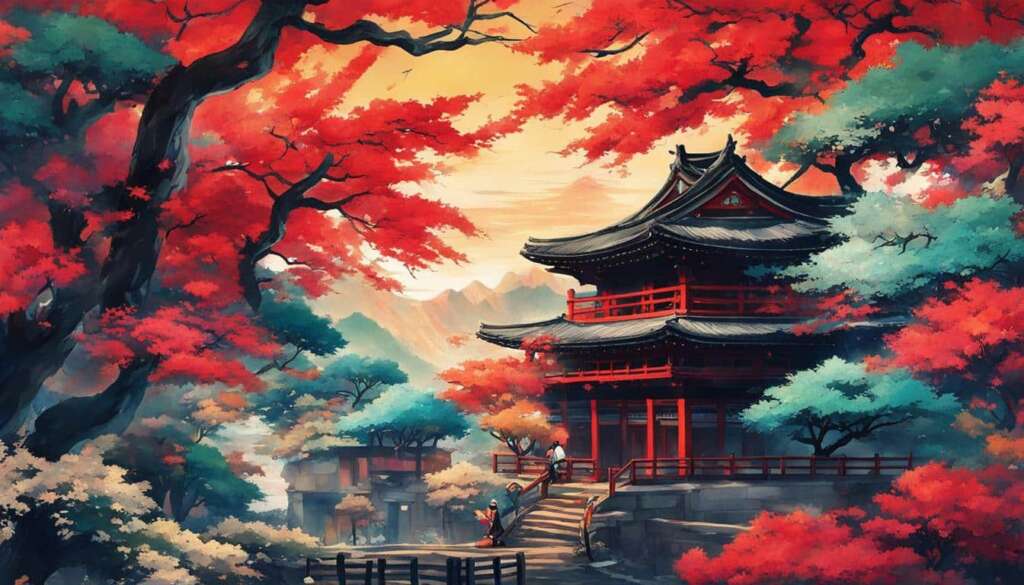Table of Contents
As a well-loved Japanese animation style, anime has garnered a worldwide audience and a devoted fan base. But what does the abbreviation “anime” actually stand for?
In this section, we’ll dive into the origins of anime and reveal the meaning behind its abbreviated name. From its cultural influences to the key milestones that have shaped its development, we’ll lay the foundation for a comprehensive understanding of this beloved animation style.
Key Takeaways
- Anime is an abbreviation for a specific type of Japanese animation style.
- The origins of anime are rooted in Japan’s rich cultural history.
- Understanding the meaning behind the abbreviation is key to appreciating the artform fully.
- Industry pioneers laid the foundation for anime’s popularity worldwide.
- Anime’s unique style and storytelling techniques have made it a beloved entertainment medium.
The Origins of Anime
Anime is a unique art form that originated in Japan and has since become a global phenomenon. To understand the history of anime, we need to explore its cultural influences and key milestones that have shaped the development of this beloved Japanese animation style.
The origins of anime can be traced back to the early 1900s when Japanese artists began experimenting with different animation techniques, most notably inspired by the works of American animator, Winsor McCay. In 1917, the first Japanese animated cartoon, “Namakura Gatana,” was released to the public.
Throughout the 20th century, anime evolved alongside Japan’s social, political, and economic changes. The style drew inspiration from a diverse range of sources, including traditional Japanese art, manga comics, and Western animation.
One of the most significant turning points in anime history was the release of “Astro Boy” in 1963. This popular anime series was a huge success in Japan and established a distinct animation style that would come to define the medium for generations to come.
In the following decades, anime gained widespread popularity both in Japan and around the world, with influential works like “Akira,” “Ghost in the Shell,” and “Spirited Away.” Today, anime continues to captivate audiences with its unique style, imaginative storytelling, and rich cultural heritage.
The Cultural Significance of Anime
Anime has become an integral part of Japanese culture, with its influence extending beyond entertainment and into various other fields like fashion, video games, and technology. Anime has also played a vital role in promoting Japanese culture globally, with millions of fans around the world embracing the medium and its unique style.
“Anime, like manga, has become a global phenomenon, with a tremendous influence on popular culture in Japan and beyond.” – Frederik L. Schodt
The emergence of anime has also had a significant impact on the animation industry worldwide, inspiring new generations of animators to experiment with new techniques and styles.
Key Milestones in Anime History
| Year | Event |
|---|---|
| 1917 | The release of the first Japanese animated cartoon, “Namakura Gatana.” |
| 1963 | The release of “Astro Boy,” one of the most influential anime series of all time. |
| 1988 | The release of “Akira,” a groundbreaking anime film that revolutionized the animation industry. |
| 2001 | “Spirited Away” becomes the first anime film to win an Academy Award for Best Animated Feature. |
As we can see, anime has come a long way since its early beginnings. With each passing year, it continues to grow and evolve, captivating audiences with its unique style and imaginative storytelling.
What Does Anime Stand For?
Have you ever wondered what the abbreviation “anime” actually means? The word “anime” is actually short for “animation”, but it is used to specifically refer to the unique style of Japanese animation that has become popular worldwide.
The abbreviation “anime” has become so widely used that it has almost entirely replaced the term “Japanimation,” which was often used in the past. This highlights the cultural significance of anime and how it has become synonymous with Japanese animation style.
The popularity of anime has led to it being adopted across various mediums, including television shows, movies, and video games. Its unique animation style, storytelling, and character development have also contributed to its appeal among fans worldwide.
What’s fascinating about anime is how its popularity has led to the emergence of a large subculture, with its own distinct language, fashion, and fan conventions. This has created a thriving industry that encompasses not only entertainment but also merchandise and tourism.
“Anime has become an integral part of Japanese culture, and its impact has been felt worldwide.”
As we have seen, anime is more than just a form of entertainment; it is a cultural phenomenon that has gone beyond Japan and has gained worldwide recognition. It is an excellent representation of how popular culture can bring people together and create a shared experience.
Conclusion
After exploring the abbreviation of anime and its origins, we can conclude that “anime” is short for “animation” in Japanese. Anime emerged as a distinct form of entertainment in the early 20th century and has since grown to become a popular worldwide phenomenon.
Key takeaways from this article include understanding the cultural influences that shaped anime, as well as its unique animation style. We also explored the meaning behind the abbreviation of anime and its significance in representing this distinct form of entertainment.
In summary, anime is a special form of Japanese animation that has evolved over time and continues to captivate audiences globally. Understanding its origins and significance can help us appreciate the art form and its cultural importance.
FAQ
What is the definition of anime?
Anime is a style of animation that originated in Japan and is characterized by its distinctive art style, vibrant visuals, and often fantastical or futuristic themes.
How did anime originate?
Anime has its roots in early Japanese animation, which was heavily influenced by Western cartoons. However, it evolved into a distinct form of entertainment in the early 20th century, with the introduction of feature-length animations and the influence of Japanese cultural aesthetics.
What is the abbreviation “anime” short for?
The term “anime” is actually an abbreviation of the word “animation” in Japanese. It is used to refer specifically to the unique style of animation that originated in Japan.
What are some key milestones in the history of anime?
Some significant milestones in the history of anime include the release of “Astro Boy” in 1963, which is considered the first popular anime series, and the emergence of Studio Ghibli in the 1980s, which produced critically acclaimed films like “Spirited Away” and “Princess Mononoke.”
Why is anime so popular?
Anime has gained popularity worldwide due to its compelling storytelling, diverse genres, and visually appealing animation. It often explores complex themes, offers unique perspectives, and provides engaging narratives that resonate with a global audience.
Can anime be enjoyed by people of all ages?
Yes, anime caters to a wide range of audiences, from children to adults. There are anime series and films specifically created for younger viewers, as well as those with more mature themes and content aimed at adult audiences.













